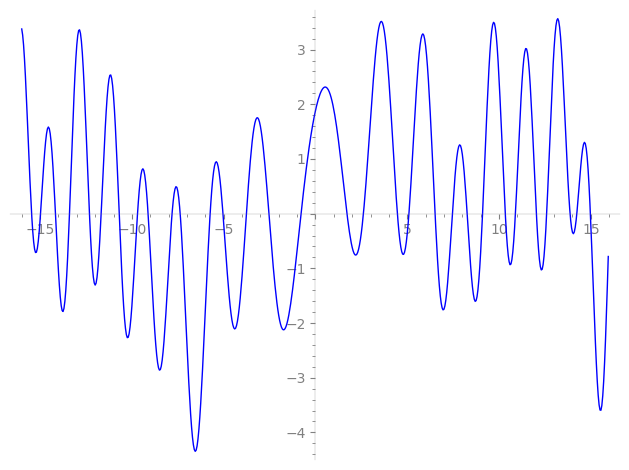| L(s) = 1 | + (0.746 + 0.746i)3-s + (0.822 − 0.822i)5-s + (6.88 − 1.28i)7-s − 7.88i·9-s + (−2.57 − 2.57i)11-s + (−14.9 − 14.9i)13-s + 1.22·15-s − 20.7i·17-s + (10.0 + 10.0i)19-s + (6.09 + 4.17i)21-s + 19.5i·23-s + 23.6i·25-s + (12.6 − 12.6i)27-s + (7.24 − 7.24i)29-s − 45.5i·31-s + ⋯ |
| L(s) = 1 | + (0.248 + 0.248i)3-s + (0.164 − 0.164i)5-s + (0.982 − 0.183i)7-s − 0.876i·9-s + (−0.234 − 0.234i)11-s + (−1.15 − 1.15i)13-s + 0.0818·15-s − 1.21i·17-s + (0.531 + 0.531i)19-s + (0.290 + 0.198i)21-s + 0.851i·23-s + 0.945i·25-s + (0.466 − 0.466i)27-s + (0.249 − 0.249i)29-s − 1.46i·31-s + ⋯ |
\[\begin{aligned}\Lambda(s)=\mathstrut & 448 ^{s/2} \, \Gamma_{\C}(s) \, L(s)\cr =\mathstrut & (0.459 + 0.888i)\, \overline{\Lambda}(3-s) \end{aligned}\]
\[\begin{aligned}\Lambda(s)=\mathstrut & 448 ^{s/2} \, \Gamma_{\C}(s+1) \, L(s)\cr =\mathstrut & (0.459 + 0.888i)\, \overline{\Lambda}(1-s) \end{aligned}\]
Particular Values
| \(L(\frac{3}{2})\) |
\(\approx\) |
\(1.883850936\) |
| \(L(\frac12)\) |
\(\approx\) |
\(1.883850936\) |
| \(L(2)\) |
|
not available |
| \(L(1)\) |
|
not available |
\(L(s) = \displaystyle \prod_{p} F_p(p^{-s})^{-1} \)
| $p$ | $F_p(T)$ |
|---|
| bad | 2 | \( 1 \) |
| 7 | \( 1 + (-6.88 + 1.28i)T \) |
| good | 3 | \( 1 + (-0.746 - 0.746i)T + 9iT^{2} \) |
| 5 | \( 1 + (-0.822 + 0.822i)T - 25iT^{2} \) |
| 11 | \( 1 + (2.57 + 2.57i)T + 121iT^{2} \) |
| 13 | \( 1 + (14.9 + 14.9i)T + 169iT^{2} \) |
| 17 | \( 1 + 20.7iT - 289T^{2} \) |
| 19 | \( 1 + (-10.0 - 10.0i)T + 361iT^{2} \) |
| 23 | \( 1 - 19.5iT - 529T^{2} \) |
| 29 | \( 1 + (-7.24 + 7.24i)T - 841iT^{2} \) |
| 31 | \( 1 + 45.5iT - 961T^{2} \) |
| 37 | \( 1 + (34.5 + 34.5i)T + 1.36e3iT^{2} \) |
| 41 | \( 1 - 61.5T + 1.68e3T^{2} \) |
| 43 | \( 1 + (-16.6 - 16.6i)T + 1.84e3iT^{2} \) |
| 47 | \( 1 + 55.0iT - 2.20e3T^{2} \) |
| 53 | \( 1 + (-38.2 - 38.2i)T + 2.80e3iT^{2} \) |
| 59 | \( 1 + (32.2 - 32.2i)T - 3.48e3iT^{2} \) |
| 61 | \( 1 + (32.0 + 32.0i)T + 3.72e3iT^{2} \) |
| 67 | \( 1 + (42.1 - 42.1i)T - 4.48e3iT^{2} \) |
| 71 | \( 1 - 15.7iT - 5.04e3T^{2} \) |
| 73 | \( 1 - 65.7T + 5.32e3T^{2} \) |
| 79 | \( 1 - 96.5T + 6.24e3T^{2} \) |
| 83 | \( 1 + (-31.6 - 31.6i)T + 6.88e3iT^{2} \) |
| 89 | \( 1 - 89.3T + 7.92e3T^{2} \) |
| 97 | \( 1 - 47.6iT - 9.40e3T^{2} \) |
| show more | |
| show less | |
\(L(s) = \displaystyle\prod_p \ \prod_{j=1}^{2} (1 - \alpha_{j,p}\, p^{-s})^{-1}\)
Imaginary part of the first few zeros on the critical line
−10.69056390283002536393666998977, −9.692737143356332119362823769078, −9.117258510932213615887618627092, −7.81090875156561686056362546492, −7.36967029312556339719785345048, −5.73703612079772362444373213781, −5.03806174225260345420894316180, −3.76102965978525587659031670865, −2.53424495470523931022008513366, −0.78480739797527514738195153880,
1.71666347110927652836562161401, 2.61174811043727816508699360277, 4.46305388221486040142095791999, 5.09140669470199778557614677413, 6.51536471955353581037981888474, 7.45755991411861509447840904230, 8.262676499849553242460204215408, 9.102228989550459721395398619389, 10.34012704775345800504835573656, 10.89211680559486756982488594401

